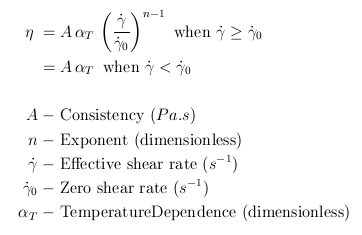Spriggs Power Law Model |

|

|

|

|
|
Spriggs Power Law Model |

|

|

|

|
This is a three-parameter model described by the following equation.

This model describes the viscosity using a power-law relationship. The exponent n determines the nature of the relationship. Unlike the power-law model where the Consistency A has complex units Pa-s^n, here the consistency is identical to viscosity. This is because the effective shear rate is normalized with zero shear rate limit. This makes the data easily understandable.
Syntax
Syntax of the data packet Polymer is as follows:
Polymer |
PolymerName |
{ |
|
ConstitutuveModel = |
"SpriggsPowerLaw" |
|
Density = |
ρ |
|
SpecificHeat = |
Cp(T) |
|
Conductivity = |
K(T) |
|
CoeffOfThermalExpansion = |
βT |
|
VolumetricHeatSource = |
Qvol |
|
Consistency = |
A |
|
Exponent = |
n |
|
ZeroShearRate = |
γ0 |
|
TemperatureDependence = |
"None" } |
Parameter |
Description |
Units |
Data Type |
Condition |
Typical Value |
ConstitutiveModel |
Describes the model used |
None |
String |
Required |
"SpriggsPowerLaw" |
Density |
Density of the polymer |
kg/m^3 |
Constant |
Required |
995.0 |
SpecificHeat |
Specific heat at constant pressure |
J/kg/K |
Constant / F(T) |
Required |
2000.0 |
Conductivity |
Thermal conductivity |
W/m/K |
Constant / F(T) |
Required |
0.167 |
CoeffOfThermalExpansion |
Indicates the change in volume with change in temperature |
1/K |
Constant |
Required |
1.0e-05 |
VolumetricHeatSource |
Heat generated/ removed in the volume by methods like electrical heating |
W/m^3 |
Constant |
Required |
0.0 |
Consistency |
One of the parameters of the power law model. When n=1 it is same as viscosity. |
Pa s |
Constant |
Required |
1.0e+04 |
Exponent |
Power law index, defines the dependency of viscosity on shear rate. |
None |
Constant |
Required |
0.66 |
ZeroShearRateLimit |
Parameter of the model to define a zero shear rate limit. This over comes the chief limitation of the traditional power-law model. |
1/s |
Constant |
Required |
0.01 |
TemperatureDependence |
None |
String |
Required |
"Exp(-Beta(DeltaT))" |
|
ReferenceTemperature |
Temperature at which data is calculated for the initialization step. |
K |
Constant |
Required only if TD is not "None" |
533 |
FreezeTemperature |
This is the no flow temperature. Below this temperature, material ceases to flow. |
K |
Constant |
Required only if TD is not "None" |
350 |
ActivationEnergy |
A parameter required by Arrhenius model. |
J/mol |
Constant |
Required only if TD is Exp(Q/RT) |
16628 |
UniversalGasConstant |
A parameter from state equation PV = nRT, R is universal Gas constant. |
J/mol/K |
Constant |
Required only if TD is Exp(Q/RT) |
8.314 |
TemperatureSensitivity |
A derived parameter which has the same physical meaning as Q/R. |
K |
Constant |
Required only if TD is Exp(Tb/T) |
2000 K |
WLFConstant1 |
Constant C1 of WLF model |
None |
Constant |
Required only if TD is WLF |
17.44 |
WLFConstant2 |
Constant C2 of WLF model. This is like DeltaT, hence the value is same in K and Celsius. |
K |
Constant |
Required only if TD is WLF |
51.6 |
GlassTransitionTemperature |
Temperature below with polymer molecules ceases to move (frozen). There are few definitions of this term. |
K |
Constant |
Required only if TD is WLF |
320 |
Beta |
Parameter in the relationship Exp(-Beta(DeltaT)) |
None |
Constant |
Required only if TD is Exp(-Beta(DeltaT)) |
0.005 |
F(T) - Function of Temperature. Can be specified as a TABLE1 or TCL function.
TD - TemperatureDependence